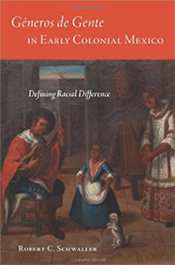Book explores origin of racial divide in early colonial Spain
LAWRENCE — In December of 1554 in Mexico City, members of Tenochtitlan's indigenous cabildo, or its city council, wrote a petition to Emperor Charles V of Spain seeking administrative changes to "save us from any Spaniard, mestizo, black or mulato afflicting us in the marketplace, on the roads, in the canal or in our homes."

For Robert Schwaller, a historian who studies the development of race in Latin America, this letter provides a key window into the identification and use of racial categories in early colonial Mexico. Examining how these racial divides occurred can be useful in better understanding — and hopefully identifying and resolving — ways that colonial notions of race continue to cause divisions and conflicts in Latin American communities, he said.
"Race is a construct and created by humans," said Schwaller, a University of Kansas assistant professor of history. "But it can be changed, and it can be overcome if we're aware of it."
His new book, "Géneros de Gente in Early Colonial Mexico: Defining Racial Difference" released this month delves into the racial identities and relationships among the many racial groups in early colonial Mexico. His research provides a new view of the ideological development and social experience of race after Spain's conquest of Mexico.

"We're exposing people to the process by which we create racial categories in all of their negative forms," Schwaller said, "but in doing that, helping us realize ways we can undo it."
The project stemmed from extensive analysis of Spanish Inquisition records to find ways inquisitors and those they interviewed or prosecuted identified people as members of particular racial categories. He later turned to letters by government officials, chroniclers' accounts and legal codes that were passed to get a sense of how the legal system codified racial categories and served to perpetuate and entrench stereotypes.
He found connections between medieval Iberian ideas of difference and the development of unique societies forged in Latin America that differentiated among Spaniards, indigenous peoples, Africans and mestizos — people with Spanish and indigenous ancestry — and mulattos — of partial African ancestry.
The development of racial stereotypes negatively affected non-Spaniards. The colonial order sought to establish a system of governance that entrenched racial differences. For example, laws prevented men of color from carrying swords without a license, even though some were able to comply if they could prove their worthiness.
"Individuals were legally bounded by racial categories, but they still found ways to transcend them, such as proving to royal officials they were trustworthy and worthy of certain, otherwise prohibited, rights," he said.
The language used to identify racial categories is also significant. Schwaller argues that in the 16th century, Spaniards had not yet developed a clear term for grouping racial categories, or "races." Instead, the documents more commonly see these categories as "géneros de gente," or "types of people.” This phrase captures the sense that Spaniards in colonial Mexico recognized their society was composed of a diversity of people divided into many types of differences: language, ethnicity, color, birthplace, wealth and social status. Only in the 17th century did racial categories come to be categorized as "castas" or "castes," defined by qualities distinct from other "types" of difference, Schwaller found.
He said his study offers a window into how race is constructed across space. While the situation in early colonial Mexico is different from settlement of the United States or Brazil, Schwaller said it is significant to point to race as a construct and trace how it evolved over time in colonial Mexico.
"One of the things the social history in the book shows is that individuals who are suffering under stigma or racial stereotypes always try to find ways to improve their position to operate as autonomously as possible within the constraints of the institutions and the social perceptions of their society," he said. "In the current moment in the United States, this is something we see going in our society today and looking back to the Civil Rights movement. It's that form of resistance and the attempt to seek a life that rejects those stigmas that began as soon as the idea of race came into being."